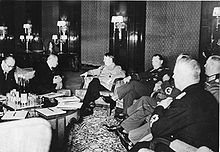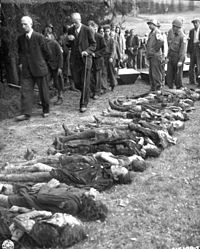- German occupation of Czechoslovakia
-
"Occupation of Czechoslovakia" redirects here. For the 1968 invasion, see Warsaw Pact invasion of Czechoslovakia.
 The partition of Czechoslovakia in 1938–1939.
The partition of Czechoslovakia in 1938–1939.
German occupation of Czechoslovakia (1938–1945) began with the Nazi annexation of Czechoslovakia's northern and western border regions, known collectively as the Sudetenland, under terms outlined by the Munich Agreement. Nazi leader Adolf Hitler's pretext for this effort was the alleged privations suffered by ethnic German populations living in those regions. There also existed new and extensive Czechoslovak border fortifications in the same area.
Following the Anschluss of Nazi Germany and Austria, in March 1938, the conquest of Czechoslovakia became Hitler's next ambition. The incorporation of Sudetenland into Nazi Germany left the rest of Czechoslovakia weak and it became powerless to resist subsequent occupation. On 16 March 1939, the German Wehrmacht moved into the remainder of Czechoslovakia and, from Prague Castle, Hitler proclaimed Bohemia and Moravia the Protectorate of Bohemia and Moravia. The occupation ended with the surrender of Germany following World War II.[1]
Contents
Demands for Sudeten autonomy
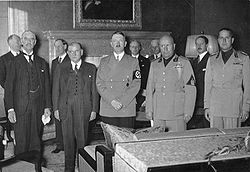 From left to right: Chamberlain, Daladier, Hitler, Mussolini, and Ciano pictured before signing the Munich Agreement, which gave the Sudetenland to Germany.
From left to right: Chamberlain, Daladier, Hitler, Mussolini, and Ciano pictured before signing the Munich Agreement, which gave the Sudetenland to Germany. Main article: Germans in Czechoslovakia (1918-1938)
Main article: Germans in Czechoslovakia (1918-1938)Sudeten German pro-Nazi leader Konrad Henlein offered the Sudeten German Party (SdP) as the agent for Hitler's campaign. Henlein met with Hitler in Berlin on 28 March 1938, where he was instructed to raise demands unacceptable to the Czechoslovak government led by president Edvard Beneš. On 24 April, the SdP issued the Carlsbad Decrees, demanding autonomy for the Sudetenland and the freedom to profess Nazi ideology. If Henlein's demands were granted, the Sudetenland would then be able to align itself with Nazi Germany.
The Munich Agreement
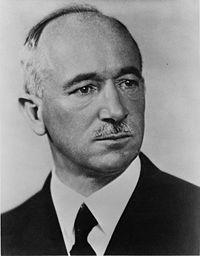 Edvard Beneš, the second President of Czechoslovakia and leader of the Czechoslovak government-in-exile.
Edvard Beneš, the second President of Czechoslovakia and leader of the Czechoslovak government-in-exile. Main article: Munich Agreement
Main article: Munich AgreementAs the previous appeasement of Hitler had shown, the governments of both France and the United Kingdom were set on avoiding war at any cost. The French government did not wish to face Nazi Germany alone and took its lead from the British government and its Prime Minister Neville Chamberlain. Chamberlain believed that Sudeten German grievances were justified and that Hitler's intentions were limited. Both Britain and France, therefore, advised Czechoslovakia to concede to the Nazi demands. Beneš resisted, and on 20 May a partial mobilization was under way in response to possible German invasion. Ten days later, Hitler signed a secret directive for war against Czechoslovakia to begin no later than 1 October.
In the meantime, the British government demanded that Beneš request a mediator. Not wishing to sever his government's ties with Western Europe, Beneš reluctantly accepted. The British appointed Lord Runciman and instructed him to persuade Beneš to agree to a plan acceptable to the Sudeten Germans. On 2 September, Beneš submitted the Fourth Plan, granting nearly all the demands of the Munich Agreement. Intent on obstructing conciliation, however, the SdP held demonstrations that provoked police action in Ostrava on 7 September. The Sudeten Germans broke off negotiations on 13 September, after which violence and disruption ensued. As Czechoslovak troops attempted to restore order, Henlein flew to Germany, and on 15 September issued a proclamation demanding the takeover of the Sudetenland by Germany.
On the same day, Hitler met with Chamberlain and demanded the swift takeover of the Sudetenland by the Third Reich under threat of war. The Czechs, Hitler claimed, were slaughtering the Sudeten Germans. Chamberlain referred the demand to the British and French governments; both accepted. The Czechoslovak government resisted, arguing that Hitler's proposal would ruin the nation's economy and lead ultimately to German control of all of Czechoslovakia. The United Kingdom and France issued an ultimatum, making a French commitment to Czechoslovakia contingent upon acceptance. On 21 September, Czechoslovakia capitulated. The next day, however, Hitler added new demands, insisting that the claims of ethnic Germans in Poland and Hungary also be satisfied.
The Czechoslovak capitulation precipitated an outburst of national indignation. In demonstrations and rallies, Czechs and Slovaks called for a strong military government to defend the integrity of the state. A new cabinet—under General Jan Syrový—was installed, and on 23 September a decree of general mobilization was issued. The Czechoslovak army—modern and possessing an excellent system of frontier fortifications—was prepared to fight. The Soviet Union announced its willingness to come to Czechoslovakia's assistance. Beneš, however, refused to go to war without the support of the Western powers.
On 28 September, Chamberlain appealed to Hitler for a conference. Hitler met the next day, at Munich, with the chiefs of governments of France, Italy and Britain. The Czech government was neither invited nor consulted. On 29 September, the Munich Agreement was signed by Germany, Italy, France, and Britain. The Czechoslovak government capitulated on 30 September and agreed to abide by the agreement. The Munich Agreement stipulated that Czechoslovakia must cede Sudeten territory to Germany. German occupation of the Sudetenland would be completed by 10 October. An international commission representing Germany, Britain, France, Italy, and Czechoslovakia would supervise a plebiscite to determine the final frontier. Britain and France promised to join in an international guarantee of the new frontiers against unprovoked aggression. Germany and Italy, however, would not join in the guarantee until the Polish and Hungarian minority problems were settled.
On 5 October, Beneš resigned as President of Czechoslovakia, realising that the fall of Czechoslovakia was fait accompli. Following the outbreak of World War II, he would form a Czechoslovak government-in-exile in London.
The first Vienna Award
Main article: First Vienna AwardIn early November 1938, under the first Vienna Award, which was a result of the Munich agreement, Czechoslovakia (and later Slovakia)—after it had failed to reach a compromise with Hungary and Poland—was forced by Germany and Italy to cede southern Slovakia (one third of Slovak territory) to Hungary, while Poland invaded Zaolzie territory shortly after.
As a result, Bohemia, Moravia and Silesia lost about 38% of their combined area to Germany, with some 3.2 million German and 750,000 Czech inhabitants. Hungary, in turn, received 11,882 km2 (4,588 sq mi) in southern Slovakia and southern Ruthenia; according to a 1941 census, about 86.5% of the population in this territory was Hungarian. Meanwhile Poland annexed the town of Český Těšín with the surrounding area (some 906 km2 (350 sq mi), some 250,000 inhabitants, Poles made about 36% of population[2]) and two minor border areas in northern Slovakia, more precisely in the regions Spiš and Orava. (226 km2 (87 sq mi), 4,280 inhabitants, only 0.3% Poles).
Soon after Munich, 115,000 Czechs and 30,000 Germans fled to the remaining rump of Czechoslovakia. According to the Institute for Refugee Assistance, the actual count of refugees on 1 March 1939 stood at almost 150,000.[3]
On 4 December 1938, there were elections in Reichsgau Sudetenland, in which 97.32% of the adult population voted for NSDAP. About 500,000 Sudeten Germans joined the Nazi Party which was 17.34% of the German population in Sudetenland (the average NSDAP participation in Nazi Germany was 7.85%). This means the Sudetenland was the most "pro-Nazi" region in the Third Reich.[4] Because of their knowledge of the Czech language, many Sudeten Germans were employed in the administration of the Protectorate of Bohemia and Moravia as well as in Nazi organizations (Gestapo, etc.). The most notable was Karl Hermann Frank: the SS and Police general and Secretary of State in the Protectorate.
The Second Republic (October 1938 to March 1939)
History of Czechoslovakia 
This article is part of a seriesOrigins
(1918)First Republic
(1918–1938)Second Republic and World War II
(1938–1945)Third Republic
(1945–1948)Communist Era
(1948–1989)Velvet Revolution and Democracy
(1989–1992)Dissolution
(1993)
The greatly weakened Czechoslovak Republic was forced to grant major concessions to the non-Czechs. The executive committee of the Slovak People's Party met at Žilina on 5 October 1938, and with the acquiescence of all Slovak parties except the Social Democrats formed an autonomous Slovak government under Jozef Tiso. Similarly, the two major factions in Subcarpathian Ruthenia, the Russophiles and Ukrainophiles, agreed on the establishment of an autonomous government, which was constituted on 8 October. Reflecting the spread of modern Ukrainian national consciousness, the pro-Ukrainian faction, led by Avhustyn Voloshyn, gained control of the local government and Subcarpathian Ruthenia was renamed Carpatho-Ukraine.
A last-ditch attempt to save Czecho-Slovakia from total ruin was made by the British and French governments, who on 27 January 1939, concluded an agreement of financial assistance with the Czech government. In this agreement, the British and French governments undertook to lend the Czech government ₤8,000,000 and make a gift of ₤4,000,000. Part of the funds was allocated to help resettle Czechs who had fled from territories lost to Czechoslovakia in the Munich Agreement or the Vienna Arbitration Award.[5]
In November 1938, Emil Hácha—succeeding Beneš—was elected president of the federated Second Republic, renamed Czecho-Slovakia and consisting of three parts: Bohemia and Moravia, Slovakia, and Carpatho-Ukraine. Lacking its natural frontier and having lost its costly system of border fortification, the new state was militarily indefensible. In January 1939, negotiations between Germany and Poland broke down. Hitler—intent on war against Poland—needed to eliminate Czechoslovakia first. He scheduled a German invasion of Bohemia and Moravia for the morning of 15 March. In the interim, he negotiated with the Slovak People's Party and with Hungary to prepare the dismemberment of the republic before the invasion. On 13 March, he invited Tiso to Berlin and on 14 March, the Slovak Diet convened and unanimously declared Slovak independence. Carpatho-Ukraine also declared independence but Hungarian troops occupied it on 15 March and eastern Slovakia on 23 March.
Hitler summoned President Hácha to Berlin and during the early hours of 15 March, informed Hácha of the imminent German invasion. Threatening a Luftwaffe attack on Prague, Hitler persuaded Hácha to order the capitulation of the Czechoslovak army. Hácha suffered a heart attack during the meeting, and had to be kept awake by medical staff, eventually giving in and accepting Hitler's surrender terms. Then on the morning of 15 March, German troops entered Bohemia and Moravia, meeting practically no resistance (the only instance of organized resistance took place in Místek where an infantry company commanded by Karel Pavlík fought invading German troops). The Hungarian invasion of Carpatho-Ukraine encountered resistance but the Hungarian army quickly crushed it. On 16 March, Hitler went to Czechoslovakia and from Prague Castle proclaimed Bohemia and Moravia a German protectorate (Protectorate of Bohemia and Moravia).
Thus, independent Czechoslovakia collapsed in the wake of foreign aggression and internal tensions. Subsequently, interwar Czechoslovakia has been idealized by its proponents as the only bastion of democracy surrounded by authoritarian and fascist regimes. It has also been condemned by its detractors as an artificial and unworkable creation of intellectuals supported by the great powers. Both views have some validity. Interwar Czechoslovakia comprised lands and peoples that were far from being integrated into a modern nation-state. Moreover, the dominant Czechs—who had suffered political discrimination under the Habsburgs—were not able to cope with the demands of other nationalities; however, it should be acknowledged that some of the minority demands served as mere pretexts to justify intervention by Nazi Germany. Considering that Czechoslovakia was able to maintain a viable economy and a democratic political system under such circumstances was indeed a remarkable achievement during the inter-war period.
Second World War
Division of Czechoslovakia
Main articles: Protectorate of Bohemia and Moravia and Slovak Republic (1939-1945)During World War II, Czechoslovakia ceased to exist. Its territory was divided into the Protectorate of Bohemia and Moravia and the newly-declared Slovak Republic, while the considerable part of Czechoslovakia was directly joined to the Third Reich. Some parts (e.g. Zaolzie, Southern Slovakia) were annexed by Poland and Hungary in the fall of 1938. The Zaolzie region was directly joined to the Third Reich after the German invasion of Poland in September 1939.
The German economy—burdened by heavy militarisation—urgently needed foreign currency. Setting up an artificially-high exchange rate between the Czechoslavak Koruna and the Reichsmark brought consumer goods to Germans (and soon created shortages in the Czech lands).
Czechoslovakia was a major manufacturer of machine guns, tanks, and artillery, most of which were assembled in the Škoda factory and had a modern army of 35 divisions. Many of these factories continued to produce Czech designs until factories were converted for German designs. Czechoslovakia also had other major manufacturing companies. Entire steel and chemical factories were moved from Czechoslovakia and reassembled in Linz, Austria which incidentally remains a heavily industrialized sector of the country.
Czech resistance
Main article: Czech resistance to Nazi occupationBeneš—the leader of the Czechoslovak government-in-exile—together with František Moravec—head of Czechoslovak military intelligence—organized and coordinated a resistance network. Hácha, Prime Minister Eliáš, and the Czech resistance acknowledged Beneš's leadership. Active collaboration between London and the Czechoslovak home front was maintained throughout the war years. The most important event of the resistance was the Operation Anthropoid, the assassination of Reinhard Heydrich, SS leader Heinrich Himmler's deputy and the then Protector of Bohemia and Moravia. Infuriated, Hitler ordered the arrest and execution of 10,000 randomly selected Czechs, but, after consultations, he reduced his response.[6] Over 10,000 were arrested, and at least 1,300 executed. The assassination resulted in one of the most well-known reprisals of the war. The village of Lidice and Ležáky was completely destroyed by the Nazis; all men over 16 years of age from the village were murdered and the rest of the population was sent to Nazi concentration camps where many women and nearly all the children were killed.
The Czech resistance comprised four main groups:
- The army command coordinated with a multitude of spontaneous groupings to form the Defense of the Nation (Obrana národa, ON) with branches in Britain and France. Czechoslovak units and formations with overwhelming majority of Czechs (cca 82-85 %) served with the Polish Army (Czechoslovak Legion), the French Army, the Royal Air Force, the British Army (the 1st Czechoslovak Armoured Brigade), and the Red Army (I Corps). Thousands of Czech troops fought alongside the British during the war in areas such as North Africa and Palestine.[7] Among other, Czech fighter pilot, sergeant Josef František was one of the most famous Czech personalities as being the number one allied ace in the Battle of Britain.
- Beneš's collaborators, led by Prokop Drtina, created the Political Center (Politické ústředí, PÚ). The PÚ was nearly destroyed by arrests in November 1939, after which younger politicians took control.
- Social democrats and leftist intellectuals, in association with such groups as trade-unions and educational institutions, constituted the Committee of the Petition We Remain Faithful (Petiční výbor Věrni zůstaneme, PVVZ).
- The Communist Party of Czechoslovakia (KSČ) was the fourth major resistance group. The KSČ had been one of over twenty political parties in the democratic First Republic, but it had never gained sufficient votes to unsettle the democratic government. After the Munich Agreement, the leadership of the KSČ moved to Moscow and the party went underground. Until 1943, however, KSČ resistance was weak. The Nazi-Soviet Nonaggression Pact in 1939 had left the KSČ in disarray. But ever faithful to the Soviet line, the KSČ began a more active struggle against the Nazis after Germany's attack on the Soviet Union in June 1941.
The democratic groups—ON, PÚ, and PVVZ—united in early 1940 and formed the Central Committee of the Home Resistance (Ústřední výbor odboje domácího, ÚVOD). Involved primarily in intelligence gathering, the ÚVOD cooperated with a Soviet intelligence organization in Prague. Following the Nazi invasion of the Soviet Union in June 1941, the democratic groups attempted to create a united front that would include the KSČ. Heydrich's appointment in the fall thwarted these efforts. By mid-1942, the Nazis had succeeded in exterminating the most experienced elements of the Czech resistance forces.
Czech forces regrouped in 1942–1943. The Council of the Three (R3)—in which the communist underground was also represented—emerged as the focal point of the resistance. The R3 prepared to assist the liberating armies of the U.S. and the Soviet Union. In cooperation with Red Army partisan units, the R3 developed a guerrilla structure.
Guerrilla activity intensified after the formation of a provisional Czechoslovak government in Košice on 4 April 1945. "National committees" took over the administration of towns as the Germans were expelled. More than 4,850 such committees were formed between 1944 and the end of the war under the supervision of the Red Army. On 5 May, a national uprising began spontaneously in Prague, and the newly formed Czech National Council (Česká národní rada) almost immediately assumed leadership of the revolt. Over 1,600 barricades were erected throughout the city, and some 30,000 Czech men and women battled for three days against 37,000–40,000 German troops backed by tanks and artillery. On 8 May, the German Wehrmacht capitulated; Soviet troops arrived on 9 May.
Slovak National Uprising
Main article: Slovak National UprisingThe Slovak National Uprising ("1944 Uprising") was an armed struggle between Nazi German Wehrmacht forces and rebel Slovak troops from August–October 1944. It was centered at Banská Bystrica.
The rebel Slovak Army, formed to fight the Nazis, had an estimated 18,000 soldiers in August, a total which first increased to 47,000 after mobilisation on 9 September 1944, and later to 60,000, plus 20,000 partisans. However, in late August, German troops were able to disarm the Eastern Slovak Army, which was the best equipped, and thus significantly decreased the power of the Slovak Army. Many members of this force were sent to concentration camps in the Third Reich; others escaped and joined partisan units or returned home.
The Slovaks were aided in the Uprising by soldiers and partisans from the Soviet Union, France, Czechia and Poland. In total, 32 nations were involved in the Uprising.
Czechoslovak Government-in-Exile
Main article: Czechoslovak Government-in-ExileEdvard Beneš had resigned as president of the first Czechoslovak Republic on 5 October 1938 after the Nazi coup. In London, he and other Czechoslovak exiles organized a Czechoslovak government-in-exile and negotiated to obtain international recognition for the government and a renunciation of the Munich Agreement and its consequences. After World War II broke out, a Czechoslovak national committee was constituted in France, and under Beneš's presidency sought international recognition as the exiled government of Czechoslovakia. This attempt led to some minor successes, such as the French-Czechoslovak treaty of 2 October 1939, which allowed for the reconstitution of the Czechoslovak army on French territory, yet full recognition was not reached. (The Czechoslovak army in France was established on 24 January 1940, and units of its 1st Infantry Division took part in the last stages of the Battle of France, as did some Czechoslovak fighter pilots in various French Fighter squadrons.)
Beneš hoped for a restoration of the Czechoslovak state in its pre-Munich form after the anticipated Allied victory, a false hope. The government in exile—with Beneš as president of republic—was set up in June 1940 in exile in London, with the President living at Aston Abbotts. On 18 July 1940, it was recognised by the British government. Belatedly, the Soviet Union (in the summer of 1941) and the U.S. (in winter) recognised the exiled government. In 1942, Allied repudiation of the Munich Agreement established the political and legal continuity of the First Republic and de jure recognition of Beneš's de facto presidency. The success of the Operation Anthropoid—which resulted in the British backed assassination of one of Hitler's top henchmen, Reinhard Heydrich, by Jozef Gabčík and Jan Kubiš on 27 May—influenced the Allies in this repudiation.
The Munich Agreement had been precipitated by the subversive activities of the Sudeten Germans. During the latter years of the war, Beneš worked toward resolving the German minority problem and received consent from the Allies for a solution based on a postwar transfer of the Sudeten German population. The First Republic had been committed to a Western policy in foreign affairs. The Munich Agreement was the outcome. Beneš determined to strengthen Czechoslovak security against future German aggression through alliances with Poland and the Soviet Union. The Soviet Union, however, objected to a tripartite Czechoslovak-Polish-Soviet commitment. In December 1943, Beneš's government concluded a treaty just with the Soviets.
Beneš's interest in maintaining friendly relations with the Soviet Union was motivated also by his desire to avoid Soviet encouragement of a post-war communist coup in Czechoslovakia. Beneš worked to bring Czechoslovak communist exiles in Britain into cooperation with his government, offering far-reaching concessions, including nationalization of heavy industry and the creation of local people's committees at the war's end. In March 1945, he gave key cabinet positions to Czechoslovak communist exiles in Moscow.
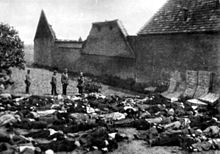 Civilians massacred in village Lidice, 10 June 1942, by Nazis
Civilians massacred in village Lidice, 10 June 1942, by Nazis
Especially after the Nazi reprisals for the assassination of Reinhard Heydrich, most of the Czech resistance groups demanded, based on German Nazi terror during occupation, the "final solution of the German question" (Czech: konečné řešení německé otázky) which would have to be "solved" by deportation of the ethnic Germans from their homeland.[8] These reprisals included massacres in villages Lidice and Ležáky, although these villages were not connected with Czech resistance.[9]
These demands were adopted by the Government-in-Exile, which sought the support of the Allies for this proposal, beginning in 1943.[10][11][11] During the occupation of Czechoslovakia, the Czechoslovak Government-in-Exile promulgated a series of laws that are now referred to as the "Beneš decrees". One part of these decrees dealt with the status of ethnic Germans and Hungarians in postwar Czechoslovakia, and laid the ground for the deportation of some 3,000,000 Germans and Hungarians from the land that had been their home for centuries (see expulsion of Germans from Czechoslovakia, and Hungarians in Slovakia). The Beneš decrees declared that German property was to be confiscated without compensation. However, the final agreement authorizing the forced population transfer of the Germans was not reached until 2 August 1945 at the end of the Potsdam Conference.
End of the war
On 8 May 1944, Beneš signed an agreement with Soviet leaders stipulating that Czechoslovak territory liberated by Soviet armies would be placed under Czechoslovak civilian control.
On 21 September, Czechoslovak troops formed in the Soviet Union liberated the village Kalinov, the first liberated settlement of Czechoslovakia near the Dukla Pass in northeastern Slovakia. Czechoslovakia was liberated mostly by Soviet troops (the Red Army), supported by Czech and Slovak resistance, from the east to the west; only southwestern Bohemia was liberated by other Allied troops from the west. Except for the brutalities of the German occupation in Bohemia and Moravia (after the August 1944 Slovak National Uprising also in Slovakia), Czechoslovakia suffered relatively little from the war. Even at the end of the war, German troops massacred Czech civilians, as was for example in Massacre in Trhová Kamenice or Massacre in Javoříčko.
A provisional Czechoslovak government was established by the Soviets in the eastern Slovak city of Košice on 4 April 1945. "National committees" (supervised by the Red Army) took over the administration of towns as the Germans were expelled. Bratislava was taken by the Soviets on 4 April. Prague was taken on 9 May by Soviet troops during the Prague Offensive. When the Soviets arrived, Prague was already in a general state of confusion due to the Prague Uprising. Soviet and other Allied troops were withdrawn from Czechoslovakia in the same year.
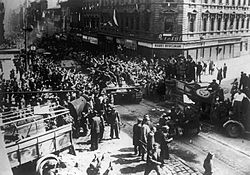 Residents and defenders of the Prague Uprising barricades greet the Soviet tankists and soldiers during the liberation of the city as part of the Prague Offensive, May 1945.
Residents and defenders of the Prague Uprising barricades greet the Soviet tankists and soldiers during the liberation of the city as part of the Prague Offensive, May 1945.
On May 5, 1945, in the last moments of the war in Europe, the Prague uprising (Czech: Pražské povstání) began. It was an attempt by the Czech resistance to liberate the city of Prague from German occupation during World War II. The uprising went on until May 8, 1945, ending in a ceasefire the day before the arrival of the Red Army and one day after Victory in Europe Day.
It is estimated that about 345,000 World War II casualties were from Czechoslovakia, 277,000 of them Jews. As many as 144,000 Soviet troops died during the liberation of Czechoslovakia.[12]
Annexation of Subcarpathian Ruthenia by the Soviet Union
In October 1944, Subcarpathian Ruthenia was taken by the Soviets. A Czechoslovak delegation under František Němec was dispatched to the area. The delegation was to mobilize the liberated local population to form a Czechoslovak army and to prepare for elections in cooperation with recently established national committees. Loyalty to a Czechoslovak state was tenuous in Carpathian Ruthenia. Beneš's proclamation of April 1944 excluded former collaborationist Hungarians, Germans and the Rusynophile Ruthenian followers of Andrej Brody and the Fencik Party (who had collaborated with the Hungarians) from political participation. This amounted to approximately ⅓ of the population. Another ⅓ was communist, leaving ⅓ of the population presumably sympathetic to the Czechoslovak Republic.
Upon arrival in Subcarpathian Ruthenia, the Czechoslovak delegation set up headquarters in Khust, and on 30 October issued a mobilization proclamation. Soviet military forces prevented both the printing and the posting of the Czechoslovak proclamation and proceeded instead to organize the local population. Protests from Beneš's government were ignored[citation needed]. Soviet activities led much of the local population to believe that Soviet annexation was imminent. The Czechoslovak delegation was also prevented from establishing a cooperative relationship with the local national committees promoted by the Soviets. On 19 November, the communists—meeting in Mukachevo—issued a resolution requesting separation of Subcarpathian Ruthenia from Czechoslovakia and incorporation into the Ukrainian Soviet Socialist Republic. On 26 November, the Congress of National Committees unanimously accepted the resolution of the communists. The congress elected the National Council and instructed that a delegation be sent to Moscow to discuss union. The Czechoslovak delegation was asked to leave Subcarpathian Ruthenia. Negotiations between the Czechoslovak government and Moscow ensued. Both Czech and Slovak communists encouraged Beneš to cede Subcarpathian Ruthenia. The Soviet Union agreed to postpone annexation until the postwar period to avoid compromising Beneš's policy based on the pre-Munich frontiers.
The treaty ceding Carpathian Ruthenia to the Soviet Union was signed in June 1945. Czechs and Slovaks living in Subcarpathian Ruthenia and Ruthenians (Rusyns) living in Czechoslovakia were given the choice of Czechoslovak or Soviet citizenship.
Expulsion of Germans from Czechoslovakia
Main article: Expulsion of Germans from Czechoslovakia Czech territories with 50% or more German population[13] before 1945
Czech territories with 50% or more German population[13] before 1945
In May 1945, Czechoslovak troops took possession of the borderland. A Czechoslovak administrative commission composed exclusively of Czechs was established. Sudeten Germans were subjected to restrictive measures and conscripted for compulsory labor.[14] On 15 June, however, Beneš called Czechoslovak authorities to order. In July, Czechoslovak representatives addressed the Potsdam Conference (the U.S., Britain and the Soviet Union) and presented plans for a "humane and orderly transfer" of the Sudeten German population. There were substantial exceptions from expulsions that applied to about 244,000 ethnic Germans who were allowed to remain in Czechoslovakia.
Following groups of ethnic Germans were not deported:
- anti-fascists
- persons crucial for industries
- those married with ethnic Czechs
It is estimated that between 700,000 and 800,000 Germans were affected by "wild" expulsions between May and August 1945.[15] The expulsions were encouraged by Czechoslovak politicians and were generally carried out by the order of local authorities, mostly by groups of armed volunteers.[16] However, in some cases it was initiated or pursued by assistance of the regular army.[16]
The expulsion according the Potsdam Conference proceeded from 25 January 1946 till October of that year. An estimated 1.6 million ethnic Germans were deported to the American zone of what would become West Germany. An estimated 800,000 were deported to the Soviet zone (in what would become East Germany).[3] Several thousand died violently during the expulsion and many more died from hunger and illness as a consequence. These casualties include violent deaths and suicides, deaths in "internment camps"[17] and natural causes.[18] The joint Czech-German commission of historians stated in 1996 following numbers: The deaths caused by violence and abnormal living conditions amount approximately to 10 000 persons killed. Another 5,000–6,000 people died of unspecified reasons related to expulsion making the total amount of victims of the expulsion 15,000-16 000 (this excludes suicides, which make another approximately 3,400 cases).[19][20]
Approximately 225,000 Germans remained in Czechoslovakia, of whom 50,000 emigrated or were expelled soon after.[citation needed]
See also
- Fall Grün, the Nazi invasion plan for Czechoslovakia rendered obsolete by the Munich Agreement.
- Concentration camps Lety and Hodonín in the Czech republic
- Czechoslovak border fortifications – built 1935–1938 against Nazi Germany
- Karel Pavlík
- Western betrayal
References
- ^ Spencer Tucker, Priscilla Mary Roberts (2005). World War II: A Political, Social, and Military History. ABC-CLIO. ISBN 1576079996.
- ^ Siwek, Tadeusz (not dated). "Statystyczni i niestatystyczni Polacy w Republice Czeskiej". Wspólnota Polska. http://www.wspolnota-polska.org.pl/index.php?id=kw3_3_06.
- ^ Forced displacement of Czech population under Nazis in 1938 and 1943, Radio Prague
- ^ Zimmermann, Volker: Die Sudetendeutschen im NS-Staat. Politik und Stimmung der Bevölkerung im Reichsgau Sudetenland (1938–1945). Essen 1999. (ISBN 3884747703)
- ^ Text of the agreement in League of Nations Treaty Series, vol. 196, pp. 288–301.
- ^ The assassination of Reinhard Heydrich
- ^ Czechoslovak Bn. no. 11 on British & Commonwealth Orders of Battle
- ^ Naše geografická situace a historie naší země od 10. století tu může býti všem dostatečným důvodem a dokladem k tomu, že toto konečné řešení německé otázky u nás je naprosto nezbytné, jedině správné a opravdu logické.[1]
- ^ HISTORY OF LIDICE VILLAGE
- ^ [2]
- ^ a b Československo-sovětské vztahy v diplomatických jednáních 1939–1945. Dokumenty. Díl 2 (červenec 1943 – březen 1945). Praha. 1999. (ISBN 808547557X)
- ^ THE 5TH EXHIBITION: THE ANNALS OF THE GREAT PATRIOTIC WAR REFLECTED IN WAR MEMORIALS
- ^ Newman, Bernard (1972). The new Europe. Ayer Publishing. p. 382. ISBN 0836929632. http://www.google.de/books?id=gTA34DxHx4AC&pg=PA382. Retrieved 2 October 2009.
- ^ http://cadmus.iue.it/dspace/bitstream/1814/2599/1/HEC04-01.pdf
- ^ The Expulsion of 'German' Communities from Eastern Europe at the end of the Second World War, Steffen Prauser and Arfon Rees, European University Institute, Florence. HEC No. 2004/1. p.17
- ^ a b Biman, S. – Cílek, R.: Poslední mrtví, první živí. Ústí nad Labem 1989. (ISBN 807047002X)
- ^ P. WALLACE/BERLIN "Putting The Past To Rest", Time Magazine Monday, 11 Mar. 2002
- ^ Z. Beneš, Rozumět dějinám. (ISBN 80-86010-60-0)
- ^ http://www.fronta.cz/dotaz/odsun-pocet-umrti#pozn1 quoting Beneš, Z. – Kuklík, J. ml. – Kural, V. – Pešek, J., Odsun – Vertreibung (Transfer Němců z Československa 1945–1947), Ministerstvo mládeže a tělovýchovy ČR 2002, s. 49–50.
- ^ http://www.tschechien-portal.info/modules.php?op=modload&name=News&file=article&sid=134
Timeline of Czechoslovak statehood Timeline Origins
pre-1918The First Republic
1918 – 1938World War II
1938 – 19451945 – 1948 Coup d'état
1948 – 1989Velvet Revolution
1989 – 1992Dissolution
1993 –Bohemia
Moravia
& Silesiacrown lands of the Austrian Empire First
Czechoslovak Republic
(ČSR, 1918 – 1938)
Full boundaries and government established by the 1920 constitutionSudetenland
annexed by Nazi Germany
(1938 – 1945)Third
Czechoslovak Republic
(ČSR, 1945 – 1948)Czechoslovak Republic
(ČSR, 1948 – 1960)
Declared a people's democracy (without a formal name change) under the Ninth-of-May Constitution following the 1948 coupCzechoslovak Socialist Republic
(ČSSR, 1960 – 1989)Czech and Slovak Federal Republic
(ČSFR, 1990 – 1992)Czech Republic
Czechia
(since 1993)Second
Czechoslovak Republic
(ČSR, 1938 – 1939)
Including the autonomous regions of Slovakia and Carpathian RutheniaProtectorate of Bohemia and Moravia
(1939 – 1945)After the Prague Spring, consisted of:
Czech Socialist Republic
(ČSR, 1969 – 1992)
Slovak Socialist Republic
(SSR, 1969 – 1992)
Socialist dropped from names in 1990Slovakia territory of the
Kingdom of HungarySlovak Republic
(1939 – 1945)Slovak Republic
Slovakia
(since 1993)Southern Slovakia and Carpatho-Ukraine
Annexed by: Hungary
(1939 – 1945)Carpathian Ruthenia Zakarpattia Oblast of the Ukrainian SSR
(1944/1946 – 1991)Zakarpattia Oblast of Ukraine
(since 1991)see: Austria-Hungary Czechoslovak government-in-exile Prior antagonism Political Economic Military Invasion of Poland · Soviet invasion of Poland · Occupation of the Baltic states · Winter War · Soviet occupation of Bessarabia and Northern Bukovina · Naval cruiser Lützow · Soviet offensive plans controversy · Basis Nord · Komet Northern Sea Route Raid · German–Soviet military parade in Brest-LitovskAftermath Operation Barbarossa · Eastern Front · Katyń massacre controversy · Falsifiers of History · Baltic WayCategoryCountries occupied by Nazi Germany during World War II Albania • Austria (Anschluss) • Belarus • Belgium • Channel Islands • Czechoslovakia • Denmark • Estonia • France • Greece • Hungary • Italy • Latvia • Lithuania • Luxembourg • Monaco • The Netherlands • Norway • Poland • San Marino • Ukraine • Yugoslavia
World War II Participants Timeline Aspects GeneralWar crimes- German and Wehrmacht war crimes
- The Holocaust
- Italian war crimes
- Japanese war crimes
- Unit 731
- Allied war crimes
- Soviet war crimes
- United States war crimes
- German military brothels
- Camp brothels
- Rape during the occupation of Japan
- Comfort women
- Rape of Nanking
- Rape during the occupation of Germany
- Nazi crimes against Soviet POWs
- Italian prisoners of war in the Soviet Union
- Japanese prisoners of war in the Soviet Union
- Japanese prisoners of war in World War II
- German prisoners of war in the Soviet Union
- Finnish prisoners of war in the Soviet Union
- Polish prisoners of war in the Soviet Union
- Romanian prisoners of war in the Soviet Union
- German prisoners of war in the United States
External links
Categories:- Czech history
- Governments in exile
- 20th century in Germany
- Jewish Czechoslovak history
- National liberation movements
- Partition (politics)
- World War II Eastern European Theatre
- World War II occupied territories
- Politics of World War II
- Military history of Czechoslovakia during World War II
- German occupations
- Battles and operations of World War II involving Germany
- Battles and operations of World War II involving Czechoslovakia
Wikimedia Foundation. 2010.

